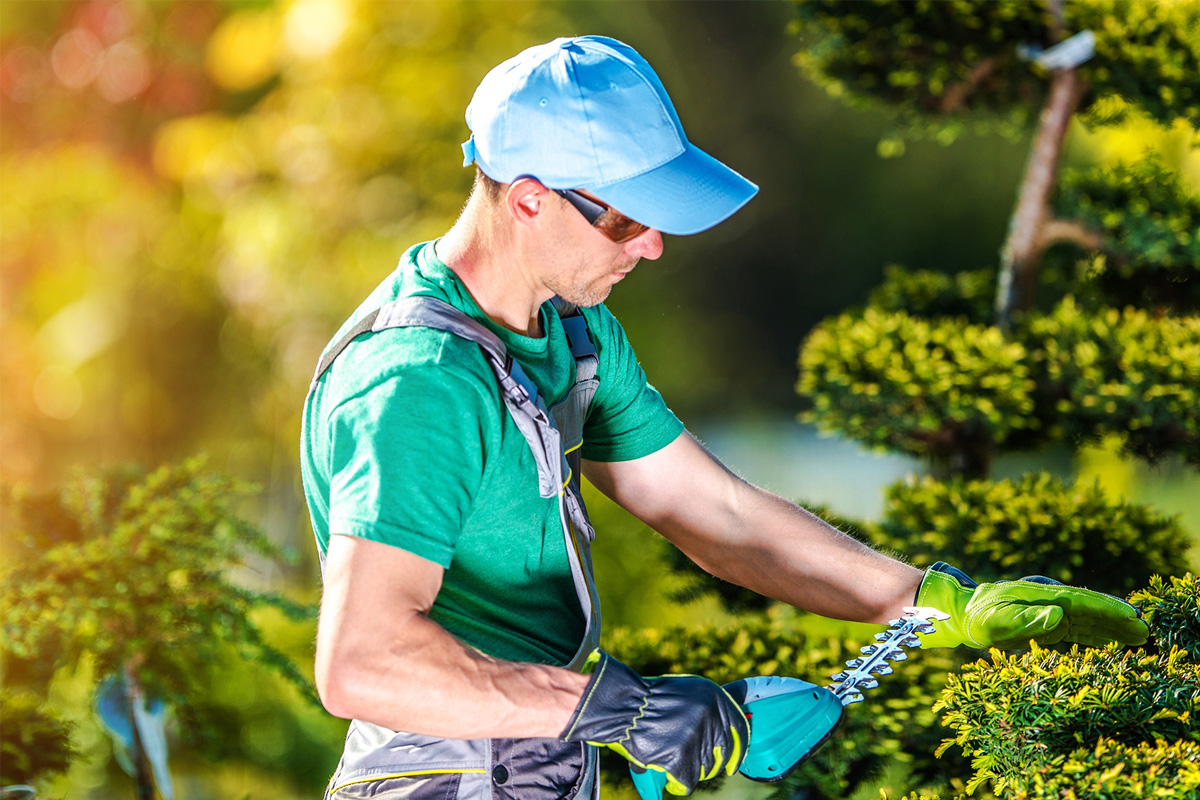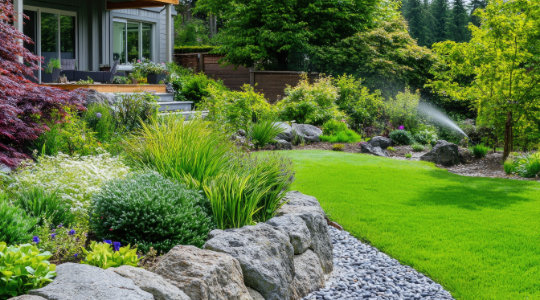Understanding the Comprehensive Scope of Works in Professional Landscape Design Services
The substantial range of specialist landscape design services includes a range of fundamental components - landscaping services. It includes landscape design concepts, plant option, and hardscaping functions. Additionally, it resolves watering systems and maintenance strategies. Each facet plays a vital role in producing functional and cosmetically pleasing outside spaces. Recognizing how these components collaborate can expose much about the art and scientific research of landscaping. Nonetheless, the trip into this detailed field is simply beginning
Landscape Design Principles
Effective landscape layout principles are vital for creating unified outside spaces that improve both visual charm and functionality (Learn More). These principles assist the plan of elements within the landscape, making certain a natural visual experience. Trick components include balance, which disperses visual weight equally; percentage, which connects the dimension of various aspects to every other and the space; and unity, which creates a feeling of integrity through regular motifs and materials

Plant Option and Setup
In the domain of specialist landscaping, plant selection and setup play a crucial duty in attaining a prospering garden. Stressing indigenous plant benefits, seasonal factors to consider, and the particular dirt and sunlight requirements of each varieties ensures a sustainable and cosmetically pleasing landscape. Cautious preparation in these areas not just enhances biodiversity however likewise promotes long-lasting eco-friendly health and wellness.
Indigenous Plant Advantages
Why should property owners take into consideration native plants for their landscaping jobs? Indigenous plants provide countless benefits that boost both visual appeals and environmental sustainability. They are well-adapted to local climates, needing much less water and upkeep contrasted to non-native species. This durability lowers the demand for chemical fertilizers and chemicals, promoting a healthier community. Additionally, indigenous plants give habitat and food for neighborhood wildlife, including pollinators, which can boost biodiversity in property locations. Their familiarity with regional dirt and climate condition additionally brings about much better development prices and durability. By picking indigenous plants, house owners not only produce aesthetically appealing landscapes yet also add to eco-friendly conservation, making a positive influence on their local atmosphere. Indigenous plants represent a smart choice for landscaping projects.
Seasonal Plant Considerations
Homeowners that have actually embraced native plants in their landscape design can better improve their exterior spaces by considering seasonal plant choices. By incorporating plants that grow in certain seasons, they can create aesthetically attractive and dynamic landscapes throughout the year. Spring may usher in vibrant blossoms like tulips and daffodils, while summer season can showcase lush foliage and vibrant perennials. Fall presents a combination of cozy tones with asters and goldenrods, while winter season can be highlighted with evergreens and ornamental lawns for appearance. Specialist landscaping companies often advise selecting plants that not only complement existing native types however likewise offer year-round interest and assistance regional wildlife. This thoughtful method to seasonal plant option assures a continuously advancing and lasting yard environment.
Soil and Sunshine Needs
Successful landscaping pivots on comprehending the details dirt and sunlight demands of plants. Different types flourish under differing conditions, needing a careful analysis of both factors throughout the choice procedure. Soil types, such as sandy, clay, or fertile, impact water drainage, nutrient accessibility, and origin advancement. In addition, pH levels can impact plant wellness, requiring dirt testing to identify viability. Sunlight demands differ significantly; some plants thrive in complete sun, while others choose full or partial shade. An expert landscaper thinks about these aspects to guarantee peak growth and aesthetic appeal. By aligning plant options with the environment's certain features, landscapes can achieve sustainability, durability, and aesthetic consistency, ultimately resulting in successful plant facility and lasting maintenance.
Hardscaping Attributes and Construction

While landscaping frequently evokes pictures of lush plant and dynamic flowers, hardscaping attributes play an essential duty in defining exterior areas. These aspects, which include patio areas, walkways, keeping wall surfaces, and ornamental stonework, give structure and performance to gardens and yards. Hardscaping makes use of materials such as concrete, rock, timber, and block, permitting diverse designs that complement the all-natural landscape.
The construction of hardscaping features calls for careful preparation and execution to ensure longevity and aesthetic allure. Professionals evaluate website problems, drain, and spatial connections to produce cohesive outdoor settings. Appropriate installation techniques are vital, as they stop concerns like disintegration and moving gradually.
Integrating hardscaping not just enhances the aesthetic rate of interest of a building yet also facilitates exterior activities, making it a fundamental aspect of thorough landscape design services. Eventually, thoughtful hardscaping adds to both the functionality and appeal of outdoor spaces.
Irrigation Solutions and Water Management
Efficient irrigation systems and water administration are crucial elements of professional landscape design, as they assure that plants receive the essential hydration for ideal development. These systems can differ from basic drip watering setups to sophisticated automatic lawn sprinkler, designed to fulfill the details requirements of diverse landscapes. Correct water management not just maximizes water use, decreasing waste, but likewise enhances plant health and lessens condition threats.
Landscaping experts examine various variables, consisting of soil type, plant species, and regional environment, to develop customized irrigation solutions. Additionally, including rain harvesting strategies can even more boost sustainability and effectiveness. Routine maintenance of watering systems is necessary to keep performance and protect against leakages, which can lead to water loss and enhanced costs (Learn More). Ultimately, a well-designed irrigation system plays a crucial duty in protecting the aesthetic allure of outdoor rooms while advertising environmental stewardship within professional landscaping practices
Yard Treatment and Upkeep Techniques
Lawn care and upkeep strategies are essential for attaining a lavish, healthy and balanced yard that enhances the total landscape. These approaches incorporate different practices focused on advertising optimal growth and visual appeal. Normal mowing is necessary, as it urges thick, also development while avoiding weeds from developing. In addition, correct fertilization provides essential nutrients, with applications tailored to the particular lawn type and soil conditions.
Watering practices need to concentrate on deep, occasional irrigation to encourage origin development, while aeration enhances soil structure and promotes vitamins and mineral absorption. Pest and condition administration is additionally crucial; identifying issues early allows for efficient therapies that decrease damage.
Finally, overseeding can renew broken or slim yards, improving thickness and shade. By executing these targeted grass care approaches, landscape look these up design experts can guarantee that backyards stay healthy and balanced and vivid throughout the periods, greatly adding to the general appeal of the building
Seasonal Landscape Treatment and Maintenance
As the periods change, proper landscape treatment comes to be important for preserving the health and wellness and charm of exterior rooms. Each season offers special challenges and requirements. In springtime, landscape professionals concentrate on pruning, planting, and feeding to urge growth. Summertime demands normal watering, weed control, and bug monitoring to safeguard recently developed plants.

Throughout the year, seasonal landscape maintenance guarantees that outside locations continue to be aesthetically attractive and healthy. Professional services can offer customized upkeep strategies that adapt to the details needs of each period, permitting building proprietors to enjoy vivid landscapes year-round. Generally, seasonal treatment is an essential facet of expert landscaping that advertises durability and visual value.

Lasting Landscape Design Practices
An expanding variety of home proprietors are welcoming lasting landscape design practices to create eco-friendly exterior rooms. These practices focus on conserving resources, improving biodiversity, and minimizing environmental effect. Native plants are typically selected for their low tide demands and compatibility with local environments, minimizing the requirement for chemical fertilizers and pesticides. Rainfall gardens and absorptive paving are employed to manage stormwater drainage, promoting groundwater recharge and lowering disintegration.
Lasting landscape design integrates organic gardening techniques that prioritize soil health and wellness and promote all-natural pest control. Efficient irrigation systems, such as drip watering and rainwater harvesting, help enhance water use. In addition, landscape developers progressively promote for the use of recycled products, such as redeemed wood and rocks, to decrease waste. By embracing these sustainable practices, residential or commercial property proprietors not only add to environmental conservation but also produce aesthetically pleasing atmospheres that can grow with minimal upkeep.
Often Asked Concerns
For how long Does a Landscaping Job Normally Take to Full?
Generally, a landscape design task can take anywhere from a couple of days to a number of weeks to finish, depending on the task's intricacy, dimension, and style requirements. Factors such as weather condition and resource accessibility likewise influence timelines.
What Variables Impact the Expense of Landscaping Services?
Numerous factors influence landscaping service costs, consisting of task size, design intricacy, worldly top quality, labor expenses, geographic location, and seasonal demand. Each component contributes distinctly to the general financial demands of a landscaping job.
Are Landscape Design Solutions Available Year-Round?
Landscape design services are generally offered year-round, although accessibility may differ based upon region, seasonal weather problems, and details solution offerings. Some services may be restricted throughout severe weather or off-peak seasons.
Do Landscape Design Companies Offer Service Warranties on Their Job?
Lots of landscape design companies do provide guarantees on their work, which can differ in length and protection. Customers are encouraged to ask about specific terms, ensuring they understand what is assured and any conditions that use.
Can I Style My Landscape Without Professional Assist?
Yes, people can make their landscapes without specialist help. They may lack competence in plant selection, format, and environmental factors to consider, potentially leading to much less efficient designs that might require pricey adjustments later on.
In the domain of specialist landscaping, plant selection and setup play a vital function in achieving a flourishing garden. Home owners that have embraced native plants in their landscape design can even more improve their outdoor areas by taking into consideration seasonal plant options. Effective landscaping pivots on recognizing the particular dirt and sunshine demands of plants. Reliable watering systems and water monitoring are vital parts of professional landscaping, as they assure that plants get the needed hydration for excellent growth. Landscape design experts evaluate various factors, consisting of soil type, plant varieties, and neighborhood climate, to establish tailored irrigation services.